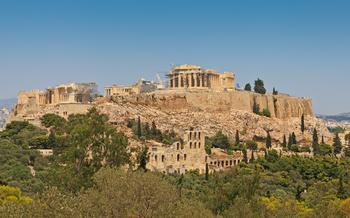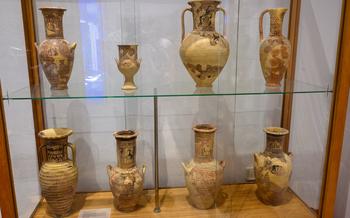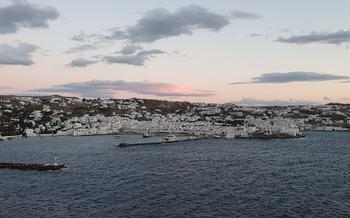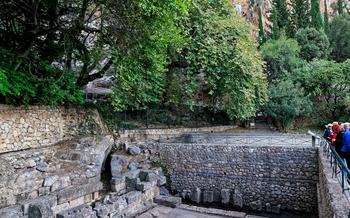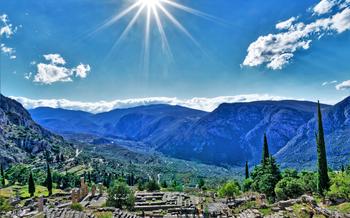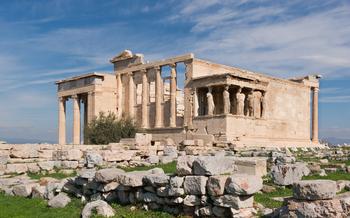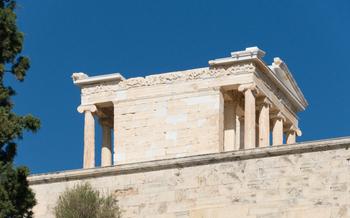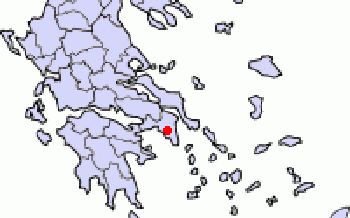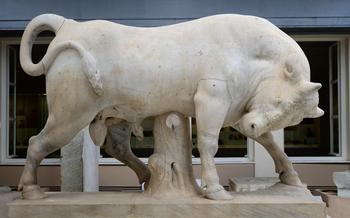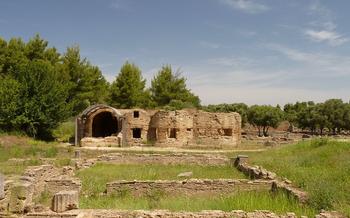
Sounion Temple of Poseidon (day trip from Athens)
- The Temple of Poseidon: A Majestic Symbol of Greek Mythology
- Getting to Sounion from Athens: A Scenic Journey
- Exploring the Temple Complex: A Journey Through History
- Unveiling the Myths and Legends of Sounion
- Tips for Visiting Sounion: Making the Most of Your Trip
- Discover the Archaeological Museum of Sounion
- Exploring the Natural Beauty of Sounion
- Unraveling the History of Sounion: A Timeline of Events
- Ancient Origins
- Rise of the Athenian Empire
- Temple Construction
- Decline and Abandonment
- The Battle of Salamis: A Turning Point in Greek History
- Sounion in Literature and Art: A Muse for Creatives
- Shopping for Souvenirs in Sounion
- Insider Tip: Capture the Perfect Photo
The Temple of Poseidon: A Majestic Symbol of Greek Mythology
The Temple of Poseidon, perched majestically atop Cape Sounion, stands as a testament to the rich history and mythology of ancient Greece. Dedicated to the sea god Poseidon, this iconic Doric temple dates back to the 5th century BC and is one of the most significant archaeological sites in the country. Its well-preserved columns, stunning location overlooking the Aegean Sea, and captivating mythology make it a must-visit destination for anyone interested in Greek culture and history.
Poseidon, the brother of Zeus and Hades, was worshipped as the god of the sea, earthquakes, and storms. The temple's strategic position on the southernmost tip of Attica served as a beacon for sailors navigating the treacherous waters of the Aegean Sea. According to mythology, Poseidon and Athena, the goddess of wisdom and war, engaged in a fierce rivalry over who would become the patron deity of Athens.
To settle their dispute, they agreed to a contest: each would bestow a gift upon the city, and the citizens would choose the more valuable one. Poseidon struck the ground with his trident, causing a spring of saltwater to erupt from the earth, symbolizing his power over the seas. Athena, in turn, gifted the city with an olive tree, representing wisdom, peace, and prosperity. The Athenians, recognizing the practical value of Athena's gift, chose her as their patron goddess, and Poseidon, in his anger, sent a flood to inundate the city.
Getting to Sounion from Athens: A Scenic Journey
Distance and travel time:
Sounion is located approximately 70 kilometers from Athens, and the journey takes about an hour by car. The scenic route winds along the Athens Riviera, offering breathtaking views of the Aegean Sea and the surrounding landscape.
Transportation options:
There are several transportation options available for getting to Sounion from Athens. Organized tours are a convenient choice, as they typically include transportation, a guided tour of the temple, and other attractions in the area. For a more independent experience, you can rent a car and drive to Sounion at your own pace, allowing you to explore the surrounding area at your leisure. Public buses are also an option, but they may have limited schedules and can be crowded during peak tourist season. If you prefer a more personalized experience, you can hire a private taxi or transfer service.
Driving directions:
If you choose to drive to Sounion, follow these directions:
- Start from Athens city center and head south on Syngrou Avenue.
- Continue straight on Vouliagmenis Avenue, which will take you along the Athens Riviera.
- Follow the signs for Sounion, which will lead you through the coastal towns of Vouliagmeni, Kavouri, and Varkiza.
- The road will eventually lead you to the Temple of Poseidon, where you can park your car and begin your exploration of this ancient site.
Tips for a smooth journey:
- To avoid peak traffic, aim to depart from Athens early in the morning or late in the afternoon.
- Check the road conditions before your trip, especially during the winter months when heavy rains can cause flooding or landslides.
- If you are driving, be sure to have a map or GPS device to help you navigate the route.
Exploring the Temple Complex: A Journey Through History
Sounion's temple complex is a treasure trove of ancient ruins, offering a glimpse into the religious and cultural practices of ancient Greece. The centerpiece of the complex is the Temple of Poseidon, a well-preserved Doric temple that dates back to the 5th century BC. Admire its iconic columns, intricate carvings, and stunning location perched on a hilltop overlooking the sea.
Explore the Sanctuary of Poseidon, a sacred area dedicated to the god of the sea. Discover altars, offerings, and inscriptions that shed light on the rituals and beliefs of ancient Greeks. The Archaeological Museum, located near the temple, houses a collection of artifacts unearthed from the site, including pottery, sculptures, and inscriptions. These exhibits provide valuable insights into the daily lives, religious practices, and cultural significance of Sounion.
Unveiling the Myths and Legends of Sounion
Sounion is steeped in ancient myths and legends that have captivated imaginations for centuries. According to Greek mythology, Sounion was the site of a fierce rivalry between the sea god Poseidon and the goddess Athena. Poseidon, angered by Athena's victory in becoming the patron deity of Athens, struck the Acropolis with his trident, causing a saltwater spring to erupt on the site. This spring, known as the Erechtheion, became a sacred site dedicated to both Poseidon and Athena.
Another significant legend associated with Sounion is the Battle of Salamis, a pivotal naval battle in the Greco-Persian Wars. Sounion played a crucial role in the battle as a watchtower and signaling point for the Athenian fleet. The Athenian commander, Themistocles, used Sounion to relay signals to his ships, coordinating their movements and ultimately leading to a decisive victory over the Persian navy.
Exploring the myths and legends of Sounion is a journey into the heart of ancient Greek culture and mythology. These stories provide a deeper understanding of the site's significance and offer a glimpse into the beliefs and values of the ancient Greeks. Whether through guided tours or self-guided exploration, visitors can bring these legends to life and experience the rich tapestry of Sounion's history and mythology.
Tips for Visiting Sounion: Making the Most of Your Trip
To make the most of your visit to Sounion, here are some valuable tips to keep in mind:
-
Ideal time to visit: Aim for early morning or late afternoon to avoid the crowds and the scorching heat of the midday sun. The golden light during these hours also enhances the beauty of the temple and the surrounding landscape.
-
Comfortable footwear: Wear sturdy and comfortable shoes, as you'll be walking on uneven terrain and exploring the archaeological site.
-
Sun protection: Don't forget your sunscreen and a hat to protect yourself from the strong Greek sun, especially during the summer months.
-
Water and snacks: Bring plenty of water and some snacks to stay hydrated and energized throughout your visit.
-
Guided tours: Consider joining a guided tour for a more in-depth historical and mythological context. Tours often provide insights into the significance of the temple, the myths and legends surrounding it, and the archaeological discoveries made at the site.
Following these tips will ensure a smooth and enjoyable experience as you explore the ancient Temple of Poseidon and the captivating surroundings of Sounion.
Discover the Archaeological Museum of Sounion
Nestled near the majestic Temple of Poseidon, the Archaeological Museum of Sounion houses a wealth of artifacts that unveil the rich history and cultural significance of this ancient site. Step inside and embark on a journey through time, exploring the fascinating exhibits that bring the past to life.
Discover an array of pottery, sculptures, inscriptions, and everyday objects that once belonged to the inhabitants of Sounion. These artifacts provide a glimpse into their daily lives, religious practices, and cultural traditions. Learn about the site's strategic importance as a naval base and its role in trade routes that connected Greece with the wider Mediterranean world.
Interactive displays and multimedia presentations further enhance the museum experience, offering a deeper understanding of the ancient world. Engage with virtual reconstructions, touchscreens, and audio guides to immerse yourself in the stories and legends that shaped Sounion's history.
The Archaeological Museum of Sounion is a treasure trove of knowledge, offering visitors the opportunity to delve into the fascinating past of this iconic site. Whether you're a history buff, an archaeology enthusiast, or simply curious about ancient Greece, a visit to this museum is a must.
Exploring the Natural Beauty of Sounion
Beyond the historical and mythological significance of Sounion, the region offers a stunning natural beauty that captivates visitors. The coastal views from the temple are breathtaking, with panoramic vistas of the Aegean Sea stretching out to the horizon. Embark on scenic walks along the coastal paths, enjoying the fresh sea breeze and the tranquility of the natural surroundings. Discover the unique plant and animal life that thrives in this natural setting, including wildflowers, birds, and marine creatures. Capture the beauty of the coastline, wildflowers, and wildlife through photography, preserving the memories of your visit to this enchanting place.
Unraveling the History of Sounion: A Timeline of Events
Sounion's rich history spans several millennia, leaving behind a legacy of significant events and transformations. From its prehistoric origins as a settlement to its rise as a prominent site in the Athenian Empire, Sounion has played a crucial role in various historical periods.
Ancient Origins
The earliest evidence of human presence in Sounion dates back to the Neolithic period, around 6000 BC. Archaeological excavations have revealed traces of prehistoric settlements, indicating the area's continuous habitation since ancient times. These early inhabitants relied on fishing, farming, and trading with neighboring regions.
Rise of the Athenian Empire
During the rise of the Athenian Empire in the 5th century BC, Sounion assumed strategic importance due to its geographical location. The Athenians fortified the site and established a naval base, recognizing its significance in controlling the sea routes and defending against potential invasions.
Temple Construction
The construction of the Temple of Poseidon, dedicated to the Greek god of the sea, marked a pivotal moment in Sounion's history. Built around 444-440 BC, the temple stands as a testament to the architectural prowess and religious devotion of the ancient Greeks. Its iconic Doric columns and stunning location atop a hill overlooking the Aegean Sea have made it one of the most recognizable landmarks of ancient Greece.
Decline and Abandonment
Following the decline of the Athenian Empire, Sounion's importance gradually diminished. The temple fell into disrepair, and the site was eventually abandoned. Over the centuries, natural forces and human intervention took their toll on the once-magnificent structure, leaving behind the ruins that we see today.
Despite the passage of time and the ravages of history, Sounion's legacy endures. The site remains a powerful symbol of ancient Greek culture, mythology, and maritime power, attracting visitors from around the world who come to marvel at its enduring beauty and historical significance.
The Battle of Salamis: A Turning Point in Greek History
The Battle of Salamis, fought in 480 BC, was a pivotal naval battle in the Greco-Persian Wars. It took place in the straits between the island of Salamis and the mainland, just off the coast of Sounion. The Athenian fleet, led by Themistocles, defeated the invading Persian fleet, led by King Xerxes I. This victory marked a turning point in the war, as it prevented the Persians from advancing further into Greece.
Sounion played a crucial role in the battle. Its strategic location allowed the Athenians to use it as a watchtower and signaling point. From Sounion, they could monitor the movements of the Persian fleet and send signals to their ships. The battle itself took place within sight of Sounion, with the temple of Poseidon overlooking the conflict.
The Athenian victory at Salamis was a major turning point in the war. It boosted the morale of the Greek city-states and gave them the confidence to continue fighting against the Persians. The battle also marked the beginning of the end for the Persian Empire, which was eventually defeated by the Greeks in 479 BC.
Today, the Battle of Salamis is remembered as one of the most important naval battles in history. It is a reminder of the courage and determination of the Greek people, and the importance of defending one's homeland against invasion.
Sounion in Literature and Art: A Muse for Creatives
Sounion's striking beauty and historical significance have captivated the imaginations of poets, writers, and artists for centuries. In ancient Greek literature, Sounion is mentioned in the works of Homer, Sophocles, and Euripides, who wove tales of mythology and tragedy set against the backdrop of the temple and its surroundings.
In modern times, Sounion continues to inspire creative minds. Lord Byron, the renowned Romantic poet, penned a moving poem titled "Lines Written Beneath the Temple of Poseidon at Sunium," expressing his awe and wonder at the site's grandeur. Other notable writers, such as Henry Miller and Lawrence Durrell, have also found inspiration in Sounion, incorporating it into their literary works.
Sounion's visual allure has also attracted numerous artists. The renowned Danish painter Christoffer Wilhelm Eckersberg captured the temple's majesty in his 1844 painting "View of the Temple of Poseidon at Sunion." The Greek painter Nikolaos Gyzis depicted the Battle of Salamis in his 1886 masterpiece "The Battle of Salamis," showcasing Sounion's pivotal role in the historic conflict.
Sounion's timeless beauty and rich history continue to serve as a source of inspiration for contemporary artists, who find endless creative possibilities within its ancient ruins and breathtaking landscapes.
Shopping for Souvenirs in Sounion
Sounion offers a variety of unique souvenirs and local products to remember your visit. Discover handmade crafts, pottery, and artwork created by talented local artisans, reflecting the region's rich cultural heritage. Take home a piece of the Mediterranean with authentic Greek olive oil and honey, sourced from local producers and renowned for their exceptional quality and flavor. For those drawn to Sounion's maritime history, there's a treasure trove of nautical-themed souvenirs, from model ships to decorative seashells. Don't forget to pick up books, postcards, and other mementos that capture the essence of your Sounion experience.
Insider Tip: Capture the Perfect Photo
Sounion offers a wealth of stunning photo opportunities, from the majestic temple against the backdrop of the Aegean Sea to the vibrant colors of the sunset. To capture the perfect shot, consider these insider tips:
-
Ideal Photo Spots: For iconic shots of the temple, position yourself on the eastern side of the site to capture the sunrise or on the western side for breathtaking sunset views. Explore the surrounding hills for panoramic vistas that include the temple, the sea, and the coastline.
-
Photography Tips: Use a wide-angle lens to capture the temple's grandeur and the vastness of the surrounding landscape. Experiment with different shutter speeds to create dynamic effects, such as blurring the moving clouds or capturing the flowing water of the waves.
-
Tripod Recommendation: A tripod is highly recommended, especially during low-light conditions or when using slow shutter speeds. It will help stabilize your camera and prevent blurry images.
-
Patience and Timing: Be prepared to wait for the perfect moment, especially for sunset photography. The best shots often come just before the sun dips below the horizon, when the sky is ablaze with vibrant colors.
